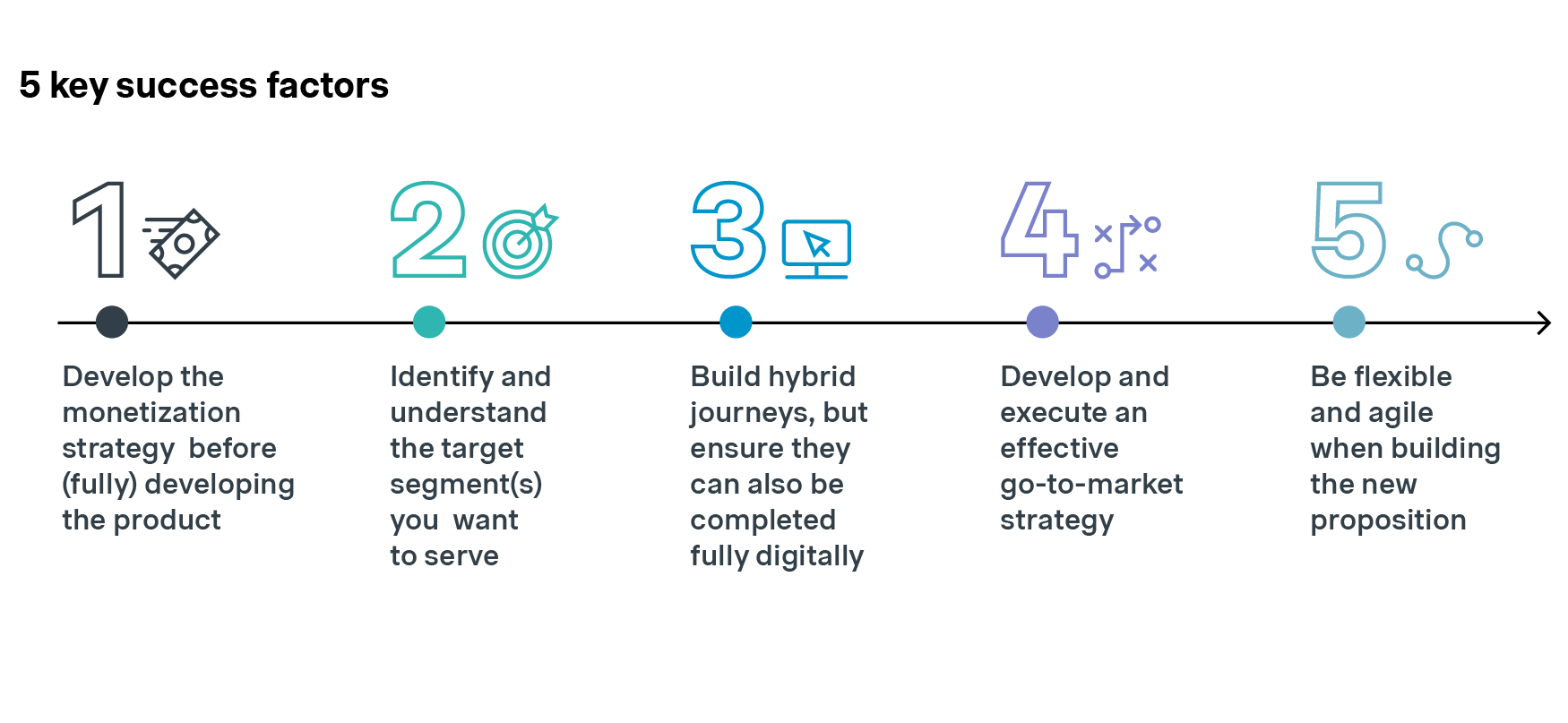The hybrid advice model is experiencing a surge in popularity, particularly among younger customers, highlighting a clear customer need. This new model is prompting many direct-to-consumer (D2C) investment platforms to consider whether they should offer financial advice to their customers. Our experts reveal five noteworthy factors for success in building a hybrid advice proposition.
At Simon Kucher we regularly conduct research into the needs of consumers with respect to investments and wealth management. We see a clear emerging trend amongst customers desiring hybrid (a combination of digital and in-person) investment advice. For example:
- A recent study in the DACH region revealed that nearly half of customers requiring advice expressed a desire for more hybrid advice models.
- A recent study in the UK showed that around 40% of customers requiring advice would prefer to use a hybrid advice model over digital-only or traditional advice. This preference was even more marked amongst “Low Confidence Investors”.
Despite growing customer interest, a noticeable advice service gap remains:
- Our study of customers of direct-to-consumer investment platforms in the UK found “lack of support to achieve their financial objectives” as the most widely stated area of improvement.
As the hybrid advice model gains more traction, it is becoming increasingly important for D2C investment platforms to establish a hybrid proposition that is aligned with market needs. The provision of the right advice, at the right time, at the right price, through the channel of preference will be a crucial factor in both competition and market growth.
Our work with clients has led us to identify five key factors that are integral to building a winning hybrid advice proposition.

Five stages of building a winning hybrid advice proposition
1. Develop the monetization strategy before (fully) developing the product.
A common mistake with innovations is to consider monetization too late in the development process. This runs the risk of misalignment between the cost of delivery and what the customer is willing to pay. A better alternative is to start by assessing what customers are willing to pay for advice and then working out how to deliver that profitably.
By starting with the monetization challenge, the product design challenge can be more clearly guided and will have a much greater chance of success. A comprehensive monetization strategy must consider the following dimensions:
- Selecting the right offer structure: When determining the offer structure, we need to start by considering the nature of the advice and how it will be used. Is it used at a single point-in-time such as a pension transfer? Will it be at regular intervals as with portfolio reviews, or will it be always available, for example, in the case of advice on buying and selling individual investments?
It is also important to consider whether groups of customers will have similar needs, in which case packages can be created, or whether a more à la carte approach is required. There are multiple options that can be considered and getting it right will both ease the buying process for customers and increase the monetization potential for the provider.
- Determining the right pricing model: When selecting metrics used to charge customers for advice (for example fixed fees or fees calculated as a percentage of assets on platform) we need to consider a range of factors including customer preferences, regulatory imperatives and business/monetization objectives.
Equally, both immediate term and long-term factors need to be considered. Subscription fees provide the highest level of clarity to the customer and revenue predictability to the platform, but % fees align better with willingness-to-pay and scale better over time.
- Measuring customers’ willingness to pay: It’s essential to understand and measure what features investors are willing to pay for in a hybrid advice solution and the potential differences across segments. As an emerging offering with very differing products in the market, market norms are unlikely on their own to be the best source of price guidance. It is therefore critical to work out what the target customer is willing to pay for the specific advice offer provided by the platform.
2. Identify and understand the target segment(s) you want to serve.
There are many needs that can be addressed by financial advice. The term covers everything from financial planning to specific stock/portfolio construction. Different customer groups will have different advice needs.
Therefore, being clear on the specific customer groups you are trying to serve and within that, the specific advice needs, is critical. Life stage factors are important, but so are degrees of financial literacy and wealth. There is a lot that must be considered in an effective segmentation.
Our experience has shown that one of the key points of failure for new advice propositions is the neglect of the pain points and preferences of their specific target customer segment. Only by understanding segment needs, behaviors (e.g., product usage), preferences and financial goals is it possible to build a relevant offer/proposition.
For this reason, we recommend our clients to conduct market research which helps validate core target segments for the hybrid proposition and understand what they value the most.
3. Make hybrid journeys ‘digital first’.
Offering the ability and flexibility to have human support when needed is essential in a hybrid model. However, one key benefit of providing digital advice over traditional in-person/human advice is that it is highly scalable and accessible. This can allow your business to serve a larger customer base without significant constraints in resources.
We therefore typically recommend to our clients that hybrid offerings are designed with a ‘digital first’ approach, where customers can complete the end-to-end journey fully digitally. Human support can be offered (either with or without a price premium) for customers that need the extra support. Such a model is likely to provide the “best of both” in terms of efficiency and customer experience.
However, in other situations where a human interaction can increase the likelihood of a sales conversion or an additional investment, providers may deliberately choose to design a human interaction into the process.
4. Develop and execute an effective go-to-market strategy.
Once you have clearly defined your value proposition and target groups, it is important to create and implement a well-structured and successful go-to-market (GTM) strategy. This should ideally include:
- A compelling brand positioning that communicates the proposition’s distinct advantages and develops messaging strategies that resonate with the target audience.
- Demand stimulation strategies, including awareness campaigns and referral programs, to generate interest and excitement.
- Tailored messaging, appropriate channels, and specific tactics for each stage of the customer journey and every segment.
5. Be flexible and agile when building the new proposition.
It is important to understand your organization’s internal IT/development capabilities, e.g., technical expertise, resources available, infrastructure, to identify areas of strengths and weaknesses. Next, assess whether all the solution components can be created in-house within the designated timeframe and scope, or if it would be more advantageous to collaborate with an external partner.
After identifying the elements that will need external support, consider forming strategic partnerships with FinTech providers or technology vendors to leverage their expertise. In our experience, partnering with the right players can accelerate time-to-market and reduce development risks and the total cost of ownership.
We consistently emphasize to our clients the importance of carefully choosing the right vendor. At Simon-Kucher, we have a proven 4-step approach: from understanding and validation of the target picture (e.g., IT landscape/status quo, use cases, features) to a comprehensive vendor evaluation and selection, enabling financial services organizations to make the best possible decision regarding partner selection.
Kickstart your hybrid advice journey with Simon-Kucher
D2C investment platforms can enhance their competitive advantage and expand their market share by implementing hybrid advice propositions.
This can be achieved by attracting new customers and increasing asset inflows from existing customers. By offering flexible and personalized financial advice solutions, you can meet the rising demand while ensuring long-term competitiveness and promoting better growth.
Should you have any inquiries regarding hybrid advice or require Simon-Kucher’s expertise in creating and launching a winning proposition for your organization, please reach out to us.



